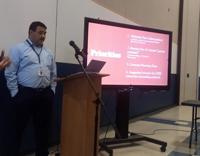CATSKILL — Teachers in the Catskill Central School District have collaboratively overhauled the elementary school day by eliminating the traditional structure of a 42-minute bell schedule to make way for a flexible approach to subject blocking that centers on students’ needs and allows for modifications day-to-day.
The new schedule will be piloted throughout the 2023-24 school year.
The pilot schedule, which provides teachers with an additional 237 minutes of unencumbered prep time, was approved by the Board of Education at the Wednesday meeting and is a formal addendum to the agreement that was negotiated this year between the board and the Catskill Teachers Association.
Catskill Elementary School principal John Rivers, assistant principal Stacey Connor, math AIS teacher Cherie Dottino and physical education teacher Caitlyn Davis presented the new schedule at the meeting.
Throughout their presentation, the panel emphasized that the design the scheduling committee devised allowed for students to get what they need. For example, if students are not comprehending a specific math concept but are quickly mastering a language arts or ELA topic, the teacher could extend the math periods one or several days while shortening the ELA time on those days.
A teacher may choose to vary the total minutes for each core subject week to week, with K-3 suggested minutes for ELA being 120 minutes, math 90 minutes and science/social studies 30 minutes. The suggested minutes for each subject at the grade 4-5 level are ELA 75 minutes, math 75 minutes and science 75 minutes.
“I don’t think this was happening in every classroom but with this schedule it can,” said Connor. “Which is great for our students.”
Each week, all grades will have 120 minutes of physical education, the activity of which enhances students’ learning in their core subjects, Davis said.
“Any of you that have children or care for them know they need to move,” Davis said. “And it helps them learn better when they’re back in the classroom, so having that four days a week is really important.”
Dottino said the additional prep time in the schedule is a much-needed benefit, as the 21st century’s gold standard of differentiating or individualizing instruction requires learning materials that vary group to group, sometimes student to student. As a result, gone are the days of a teacher designing one lesson per subject per day during his or her prep.
“That same prep hour looks like four groups, differentiated for every student, all of them learning exactly what they need to learn, so while it’s much better for our students, it requires a lot more planning time and preparation,” said Dottino.
The common planning time embedded in the schedule will help both students and teachers because it allows for collaboration between instructors covering the same subjects.
“That is just so important for teachers. If you’re teaching a curriculum to a grade level and you never have a chance to sit down with the other teachers teaching the same thing, you can’t really be on the same page. Your students are all getting something different,” said Davis. “Someone could have a great idea and want to share it, and there’s just no time to do that.”
A practical addition to the elementary schedule is time for preparing for the state’s mandated standardized tests, which are now computer-based.











